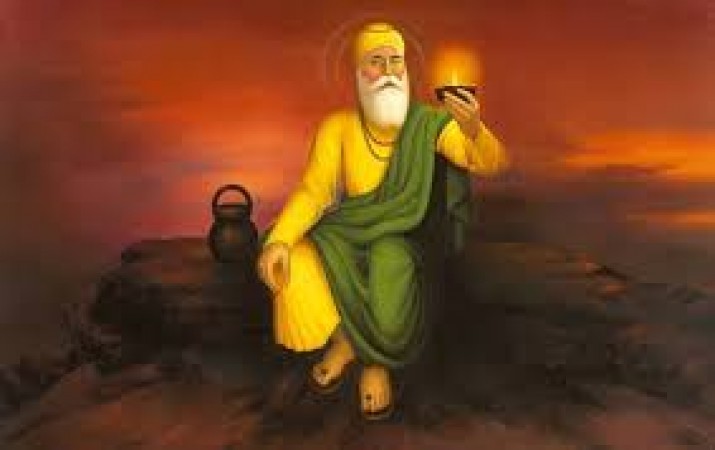
Guru Nanak Dev Ji the founder of Sikhism and First Guru of the Sikhs. He was born in 1469 in the Talwandi Village, Punjab which is now situated in Lahore Pakistan. Guru Nanak Dev Ji’s father Mehta Kalu Ji was a village accountant and his Mother Mata Tripta Ji was a simple and spiritual and very religious woman. He also had an elder sister Bebe Nanki ji who cherished and supported her younger Brother.
It was clear from an early age that Guru Nanak Ji was a unique kid who stood out for his divine grace. Young Nanak Ji would frequently astonish his elders and tutors with the sublimity of his understanding, particularly on divine topics. He was blessed with a deeply thoughtful mind and rational thinking.
He actively opposed the Caste System, idolatry, and the worship of demi-gods while he was still a child, refusing to participate in conventional religious ceremonies. By the time he was sixteen, Guru Nanak Dev Ji had learned several religious writings and tongues, including Sanskrit, Persian, and Hindi, and was producing what was widely regarded as works of heavenly inspiration.
Also Read: Gurudwara Sri Paonta Sahib
Two boys, Sri Chand, and Lakhmi Das, were born to Guru Nanak Dev ji and Mata Sulakhni ji in the year 1487. Bhai Mardana, Guru Nanak Dev Ji's childhood Muslim companion, joined the family as they relocated to Sultanpur Lodhi, where Guru Ji accepted a position as an accountant in charge of the governor's shops. While working here during the day, Guru Nanak Ji also meditated and sang hymns while being accompanied by Bhai Mardana on the rabab, a stringed instrument. One of those early mornings, while taking a bath in "Vain Nadi" (a little river), Guru Nanak Ji received a command from God to devote his entire life to serving people. The very first thing he said was, "There is no Hindu, no Musalman (Muslim)" at that time. Guru Nanak Ji then began the next phase of his life, preaching his distinctive ideology (Sikhi) to everyone on the planet, saying that he had been brought to God's court and given a divine mission.
Also Read:Gurudwara Takht Sri Harmandir Patna Sahib
Guru Nanak Dev ji traveled across India, South Asia, Tibet, and Arabia for over 30,000 kilometers over the course of the following 30 years while accompanied by Bhai Mardana on four significant spiritual travels. He preached the new definition of God during these journeys: "Supreme, All-Powerful and Truthful, Formless (Nirankar), Fearless (Nirbhau), Without Hatred (Nirvair), the Sole (Ik), the Self-Existent (Saibhang), the Incomprehensible and Everlasting Creator of All Things (Karta Purakh), and the Eternal and Absolute Truth (Satnam)."
The 'One' God, according to what Guru Ji taught, is present in all of God's creations, and all people have direct access to God without the aid of priests or rituals. Guru Nanak Dev Ji opposed the stronghold of the Hindu Caste System and denounced the theocracy of the Mughal emperors by erecting a distinctive spiritual, social, and political platform based on equality and fraternal love.
Also Read:Guru Tegh Bahadur Ji: Sacrifice for Kashmiri Pandit
He warned against the pitfalls of egotism, deception, and hypocrisy and urged people to worship using the "Naam" (God's name). His emphasis was on a householder's (family) life based on moral behavior, selfless service (Sewa), and ongoing devotion to the recollection of God's name. He opposed the road of renunciation (Tyaga). The concerns of the oppressed and the underprivileged were supported by Guru Nanak Dev ji, who placed a particular focus on promoting the equality of women.
In the last years of his life, Guru Ji created and made his home in the Punjabi township of Kartarpur (literally, "creator's town"), which is located along the banks of the Ravi River. He put on the garb of a peasant here and worked the field to make an honest living for himself. People from near and far gathered to hear the Master speak. At Kartarpur, he established the Langar institution, a free communal kitchen, establishing the fundamental equality of all people regardless of their social or economic status. After having put to the test his own two sons and a few disciples over the years, Guru Ji placed Bhai Lehna ji (Guru Angad Dev Ji) as the Second Nanak in the year 1539, realizing that the end was nigh. A few days later, Guru Ji went into Sachkhand.
Also Read:Guru Tegh Bahadur Ji: Hind Di Chaadar
The ninth Guru Arjan Dev ji included 974 spiritual hymns of Guru Nanak Dev ji, including the Japji Sahib, Asa di Var, Bara Mah, Sidh Gosht, and Dakhni Onkar, in the holy book Guru Granth Sahib. After Guru Nanak Dev ji, every Sikh Guru continued to refer to himself as Nanak when composing their cherished writings. Sikhs, therefore, hold that all the Gurus shared the same heavenly light and enhanced the same doctrine that Guru Nanak Dev Ji had spread.
Among people of various faiths and traditions, Guru Nanak Dev Ji is variously revered as Satguru Nanak, Jagat Guru Nanak, Baba Nanak, Nanak Shah Faqir, Bhagat Nanak, Nanak Kalandar.
Also Read: Guru Purnima: Celebrating the Revered Teachers on July 3rd